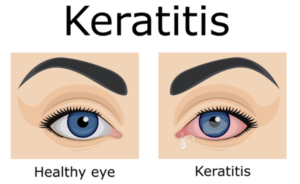What is Acanthamoeba Keratitis?
Acanthamoeba Keratitis is a rare but serious infection of the cornea (the clear front part of the eye) caused by a single-celled parasite called Acanthamoeba. People who use contact lenses are at the highest risk of developing Acanthamoeba keratitis.

Causes of Acanthamoeba Keratitis
Acanthamoeba Keratitis is caused by the parasite Acanthamoeba, which can infect the cornea of the eye. Acanthamoeba is one of the most common organisms in the environment. It’s found worldwide in soil and water. The infection is most commonly associated with injury to the cornea and poor lens hygiene, such as not cleaning lenses properly or using a contaminated solution.
Other factors that may increase the risk of infection include exposure to contaminated water (such as pools, hot tubs, or faucets), wearing lenses while swimming or showering, and having a weakened immune system.
Symptoms of Acanthamoeba Keratitis
These symptoms are common for Acanthamoeba Keratitis:
- Decreased Vision
- Sensitivity to light
- Discharge from the eye
- A feeling that there’s something in your eye
- Eye pain
- Eye redness
- Hazy or cloudy vision
- Eye irritation
It’s important to seek medical attention if you experience any of these symptoms as Acanthamoeba Keratitis can lead to serious vision problems if not treated promptly.
Treatment for Acanthamoeba Keratitis
A topical antiseptic is the most common treatment method for acanthamoeba. Antiseptics combat bacteria. It is applied on your eye’s surface directly. These treatments might be required for six months to a year. In severe cases, a combination of topical and systemic therapy may be needed.
In some cases, surgical intervention may also be needed. Treatment is typically long-term, lasting several weeks to months. The specific treatment plan will depend on the severity and extent of the infection.
Precautions
To reduce the risk of Acanthamoeba keratitis, the following precautions should be taken:
- Proper hygiene: Wash your hands before touching your eyes and avoid sharing towels, contact lenses, or solutions.
- Safe contact lens wear: Always use fresh solution for storing your lenses and replace it regularly, avoid wearing lenses in the water and handle them carefully.
- Safe water exposure: Avoid wearing contact lenses while swimming or in hot tubs and rinse your eyes thoroughly with sterile water after water exposure.
- Regular eye exams: Schedule regular eye exams to monitor your eye health and detect any early signs of infection.
- Use of disinfectants: Use only FDA-approved disinfectant solutions to clean and store your contact lenses.
By following these precautions, you can significantly reduce the risk of Acanthamoeba keratitis and maintain good eye health.
In conclusion, Acanthamoeba keratitis is a serious and potentially blinding infection of the cornea caused by a type of amoeba. Early detection and prompt treatment are crucial to prevent the progression of the disease and protect vision.
“Regular eye exams, the key to maintaining good eye health.”






